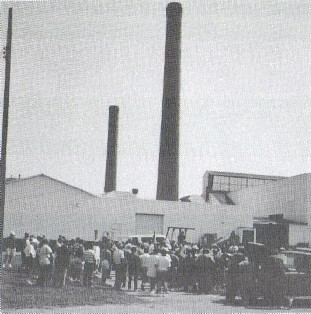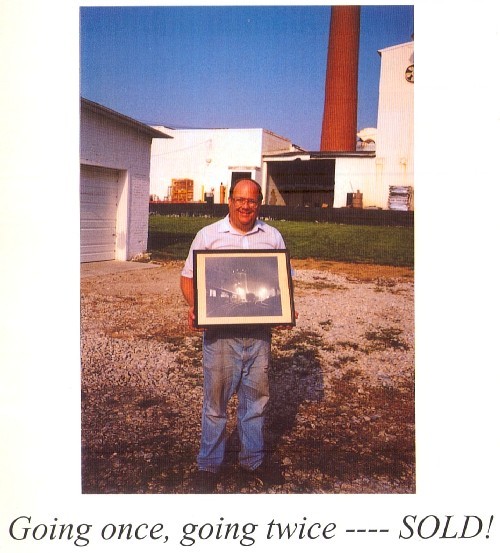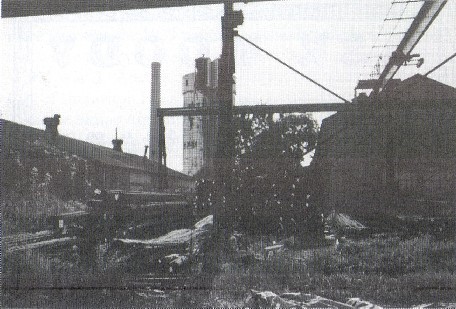AN AUCTION AT HEMINGRAY
by Bob Stahr
Reprinted from "Crown Jewels of the Wire", October 1999, page 12
It all started innocently when I was up at the old Hemingray Factory site in
Muncie, IN. It was August 8, 1998 and I was digging there again with permission
from the owner. About midday I met the owner who informed me that they were
going to have an auction in a few weeks. I got a copy of the flyer and inquired
about what types of items might be there, and the list included some items that
came from the buildings. As many of you know, this plant became a subsidiary of
Owens-Illinois Glass Co. in May of 1933. Since April of 1935 the production of
glass window block occurred at the plant in addition to insulators and other
items like TV faceplates. News of this auction was interesting; who knew if
there
were blueprints, photographs, insulators, or tools that may come up in it.
Included in the auction flyer were "Two 500,000 Gallon Oil Tanks, a Glass
Batch House, and Two Glass Furnaces".
Apparently the owners have been
wanting to get rid of the tanks, batch house, and furnaces for some time, and
they thought that the scrap value of the metal would be worth auctioning. That
night I gave Roger Lucas a call, and we decided we would meet at the auction and
find out who the high bidder would be on the demolition of the items. This
bidder may use heavy equipment in the demolition and maybe we could persuade the
contractor to dig a couple big holes for us!

Facing east toward furnace A and B chimney stacks,
the auction crowd gathers.
Auction day came on August 22 and
there were a few factory buildings, a table full of insulators including some
non-Hemingray
ones, a stack of blueprints, and a beautiful photograph of the batch tower
illuminated at night. I found out when Roger arrived that the most of the
insulators were ones that he and Darin gave the owners as appreciation to allow
them to dig there. The blueprints were mostly of certain parts of buildings,
fire sprinkler drawings and one of the plant grounds. Roger and I had both spied
the framed photograph at the same time and since he reached for it a millisecond
before I did, I let him bid on it with the stipulation "If it gets too
expensive and you don't want it, I'll jump in on the bidding".
As the
auctioneer went about the place, we waited patiently for our items to come up.
He got to the insulators first and made special note that most were made there.
Bidding started high and went from the whole group down to a "$3
choice" before anyone bid. I grabbed a CD 257 Hemingray Mickey Mouse in
clear, a CD 1070 clear spool, and a CD 183 Hemingray-71 out of the pile. The
rest Roger ended up picking up.

Photograph of the batch tower illuminated at night.
Further down the aisle we came upon the photograph. Again, the auctioneer
noted that this photograph was of this factory years ago. I estimated the
photograph from the 1950's or early 60's. Bidding began high again and went
down, This time it only got down to $20 before a bid was made. It was apparent
to both me and Roger at this time that the bidder wanted the photograph pretty
bad. Roger and the other bidder kept bidding against one another, and I could
see Roger wavering on the last two bids. I was certainly ready to jump in until
finally Roger won it for $70!

Cover Photo
Later they proceeded to go outside, where I had
seen the two pallets of glass block and the box with the blueprints in it. The
blueprints had been placed on a pallet and the bidding was for the entire
pallet. On the pallet there was also one loose glass block with factory applied
paint finish that I placed in the same box as the blueprints. I was bidding
against someone else and dropped out when it got too high. After he was the
successful bidder I asked "What would you want for the box of old
blueprints and glass block?" He replied with "How about $10?" Of
course I answered "OK" and promptly paid him. We watched a little
while longer waiting for the auctioneer to get to the furnaces, oil tanks, and
batch tower.

Looking west at the batch tower today.
Piles of steel rebar are in the
foreground.
Finally, they got to that part and there was only one bidder, but he did not have the required liability insurance. I had also found out
weeks earlier, when talking to demolition contractors in Chicago about the
auction, that the scrap metals market is very low and most demolition companies
would charge to take the stuff down rather than pay for it. It appeared this may
be the case here. There would be no sale of the tanks, batch house, or the
furnaces that day, but the story would not end. Months later Roger found out
that very same bidder who did not have the insurance was starting demolition on
the Oil Tanks and the Batch House. After talking with him, Roger found out that
the furnaces were being dismantled by another contractor and work had already
begun there, too. It seems that by removing these last items it is removing the
very heart and soul of the factory. When these are finally demolished, all that
will remain are empty warehouses and the office buildings. No hint of glass
manufacturing will be left except for the thousands of small shards spread about
the ground. These too will disappear as the grass and weeds grow again over the
next few years. At least one thing will remain for a while. The stone panel in
one of the office buildings reads HEMINGRAY GLASS COMPANY.
| 